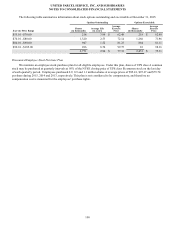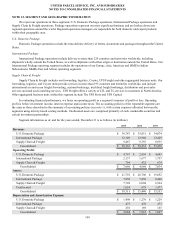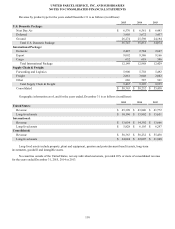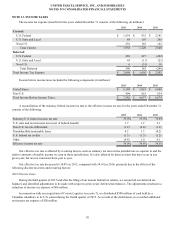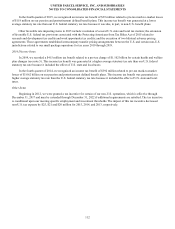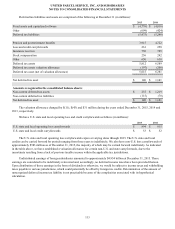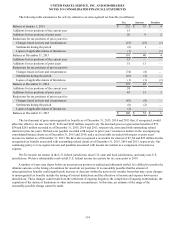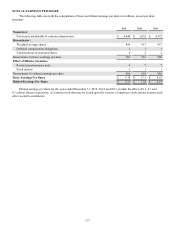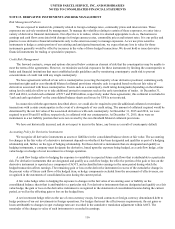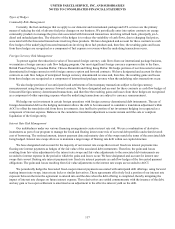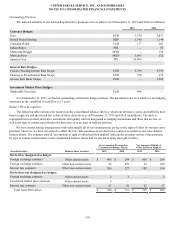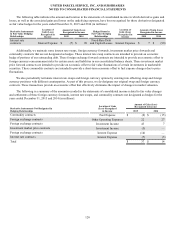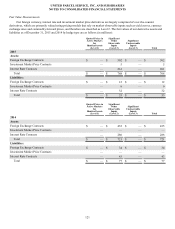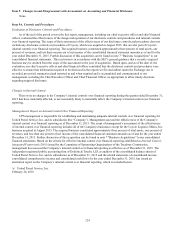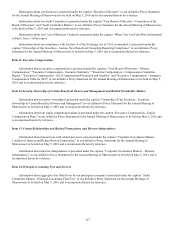UPS 2015 Annual Report Download - page 129
Download and view the complete annual report
Please find page 129 of the 2015 UPS annual report below. You can navigate through the pages in the report by either clicking on the pages listed below, or by using the keyword search tool below to find specific information within the annual report.UNITED PARCEL SERVICE, INC. AND SUBSIDIARIES
NOTES TO CONSOLIDATED FINANCIAL STATEMENTS
117
Types of Hedges
Commodity Risk Management
Currently, the fuel surcharges that we apply to our domestic and international package and LTL services are the primary
means of reducing the risk of adverse fuel price changes on our business. We periodically enter into option contracts on energy
commodity products to manage the price risk associated with forecasted transactions involving refined fuels, principally jet-A,
diesel and unleaded gasoline. The objective of the hedges is to reduce the variability of cash flows, due to changing fuel prices,
associated with the forecasted transactions involving those products. We have designated and account for these contracts as cash
flow hedges of the underlying forecasted transactions involving these fuel products and, therefore, the resulting gains and losses
from these hedges are recognized as a component of fuel expense or revenue when the underlying transactions occur.
Foreign Currency Risk Management
To protect against the reduction in value of forecasted foreign currency cash flows from our international package business,
we maintain a foreign currency cash flow hedging program. Our most significant foreign currency exposures relate to the Euro,
British Pound Sterling, Canadian Dollar, Chinese Renminbi and Hong Kong Dollar. We hedge portions of our forecasted revenue
denominated in foreign currencies with foreign currency option and forward contracts. We have designated and account for these
contracts as cash flow hedges of anticipated foreign currency denominated revenue and, therefore, the resulting gains and losses
from these hedges are recognized as a component of international package revenue when the underlying sales transactions occur.
We also hedge portions of our anticipated cash settlements of intercompany transactions subject to foreign currency
remeasurement using foreign currency forward contracts. We have designated and account for these contracts as cash flow hedges of
forecasted foreign currency denominated transactions, and therefore the resulting gains and losses from these hedges are recognized
as a component of other operating expense when the underlying transactions are subject to currency remeasurement.
We hedge our net investment in certain foreign operations with foreign currency denominated debt instruments. The use of
foreign denominated debt as the hedging instrument allows the debt to be remeasured to cumulative translation adjustment within
AOCI to offset the translation risk from those investments. Any ineffective portion of net investment hedging is recognized as a
component of interest expense. Balances in the cumulative translation adjustment accounts remain until the sale or complete
liquidation of the foreign entity.
Interest Rate Risk Management
Our indebtedness under our various financing arrangements creates interest rate risk. We use a combination of derivative
instruments as part of our program to manage the fixed and floating interest rate mix of our total debt portfolio and related overall
cost of borrowing. The notional amount, interest payment date and maturity date of the swaps match the terms of the associated debt
being hedged. Interest rate swaps allow us to maintain a target range of floating rate debt within our capital structure.
We have designated and account for the majority of our interest rate swaps that convert fixed rate interest payments into
floating rate interest payments as hedges of the fair value of the associated debt instruments. Therefore, the gains and losses
resulting from fair value adjustments to the interest rate swaps and fair value adjustments to the associated debt instruments are
recorded to interest expense in the period in which the gains and losses occur. We have designated and account for interest rate
swaps that convert floating rate interest payments into fixed rate interest payments as cash flow hedges of the forecasted payment
obligations. The gains and losses resulting from fair value adjustments to the interest rate swaps are recorded to AOCI.
We periodically hedge the forecasted fixed-coupon interest payments associated with anticipated debt offerings, using forward
starting interest rate swaps, interest rate locks or similar derivatives. These agreements effectively lock a portion of our interest rate
exposure between the time the agreement is entered into and the date when the debt offering is completed, thereby mitigating the
impact of interest rate changes on future interest expense. These derivatives are settled commensurate with the issuance of the debt,
and any gain or loss upon settlement is amortized as an adjustment to the effective interest yield on the debt.



